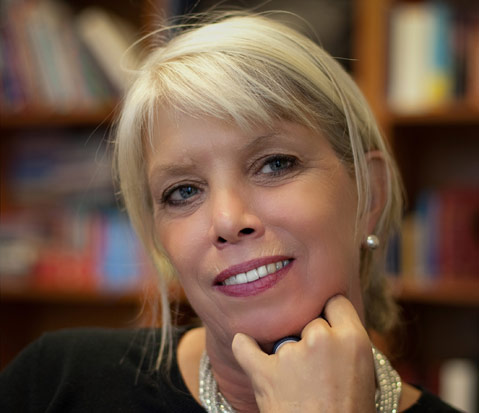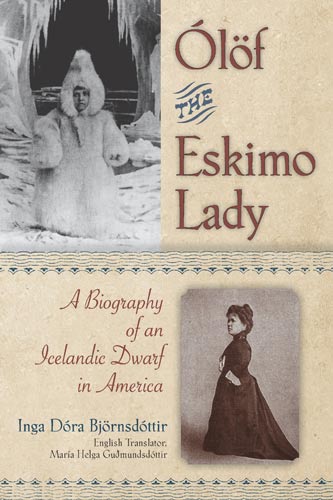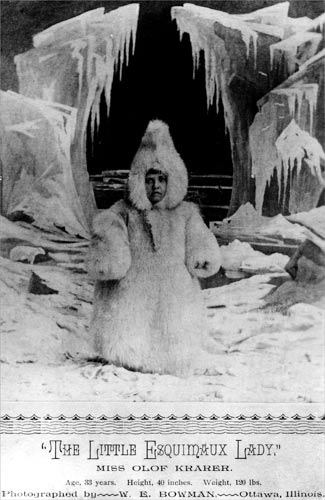Faux Esquimaux
UCSB Professor Inga Dóra Björnsdóttir’s New Study of an Exotic Impostor

“There’s a sucker born every minute,” claimed P.T. Barnum. Even beyond his storied career, 19th-century America was a heyday of hoaxers. UCSB anthropology professor Inga Dóra Björnsdóttir has brought back to light a fascinating player in that time’s colorful tradition of showmanship, exoticism, and fakery: one “Ólöf the Eskimo Lady.” In a career extending into the 1900s, Ólöf Krarer held rapt countless listeners across America with stories of her beloved home in Greenland and the ways of her Eskimo people. But she’d found plenty of suckers of her own; she was by no definition an Eskimo, and she’d never even seen Greenland.

In Ólöf the Eskimo Lady: A Biography of an Icelandic Dwarf in America, Björnsdóttir traces the life of a woman who crafted a wildly successful touring act by billing herself as what the book’s title reads. Playing off the country’s ignorance of and fascination with the outlandish, Krarer recast herself from unusually proportioned Icelandic immigrant to 100-percent normal Eskimo. Lucky for her, few Americans, even supposed experts, had much of an idea about what an Eskimo was.
It is an intriguing story, certainly, but also an obscure one. In an email conversation with The Indy, Björnsdóttir let us in on the thinking behind and development of her book. “I am Icelandic and came to the U.S.A. in 1977 to go to graduate school for anthropology,” she wrote. “This was the time when women’s studies were being introduced into the curriculum. Inspired by this, I decided to do research about Icelandic women who married American soldiers who were stationed in Iceland during World War II.”
Looking into these little-studied facts brought her closer to the historic Icelanders who made new lives in North America. “In the late 19th and early 20th century, there was, for Iceland, a ‘big wave’ of emigration to America. About 15,000 Icelanders settled in Canada and the U.S. Ólöf’s family was part of this group, and when I discovered her and her incredible story, I could not resist the temptation to write a book about her life.”
American records from that era are, unfortunately, spotty at best. Björnsdóttir initially ran into challenges finding the material she needed about Krarer in this country: “I had no personal material from Ólöf herself. This book is a combination of a social history of the era and Ólöf’s life story.” But Icelandic material about her family history surfaced, and a few unexpected American sources came through, as well. She unearthed much about the Slayton family, who not only hosted Krarer but also ran the lyceum bureau in Chicago, at which she worked for decades.

Given her fame, Krarer was noted by newspapers the country over and even became the subject of books at the time. “In 1888, Ólöf’s fictional biography, Esquimaux Lady: A Story of Her Native Home, was published: she described in detail her fictional life in Greenland, her trip to Iceland, and how she joined a group of Icelanders who were immigrating to America. This book became an important source about Eskimo culture.” She even contributed to the school textbook Eskimo Stories, which was taught in America until the Second World War. “The author recommended that the students read her chapter first, since a ‘real’ Eskimo wrote it.”
Björnsdóttir’s richest source was the papers of the Icelandic explorer Vilhjalmur Stefansson, who wrote extensively about the Eskimos of the Canadian Arctic. “Ólöf was a thorn in Stefansson’s thigh,” wrote Björnsdóttir. “He resented the fact that this little—in his eyes—pathetic woman had been in some ways more successful than he himself in shaping American views about Eskimos. Stefansson was determined to expose Ólöf and corresponded extensively with people who knew her.”
But Krarer’s associates only dished the dirt on the condition that he not expose her until after her death. This came decades after she’d left the limelight, which may be why her tale has since fallen almost into oblivion. Björnsdóttir also suspects American shame: “They who considered themselves of the best informed and most progressive of nations had, out of ignorance and prejudice, been so easily fooled by a totally uneducated female dwarf from a small, poor island in the North Atlantic.”
Even so, how could she have kept so many eyes on her for so long? “Ólöf had great talent for storytelling and acting and managed to be incredibly consistent in her tale. Her description was very much in tune with the popular view of Eskimos at this time. She just embellished her story and made it more extreme. Still, it did not make her audience suspicious. Instead, it made her even more popular!”



